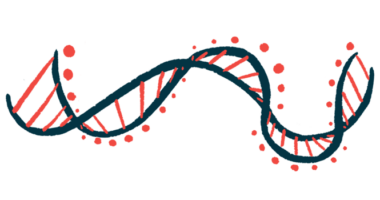Exome sequencing may help screen for AADC deficiency in children
Method found to detect DDC gene mutations in 2 youngsters

Exome sequencing, a method to decode DNA, may be useful for screening for mutations — including ones in the DDC gene — that cause aromatic L-amino acid decarboxylase (AADC) deficiency, a study from Italy suggests.
The method may help to identify such mutations in children who have symptoms of an undiagnosed neurodevelopmental disorder, according to researchers.
Mutations in DDC, the gene that’s affected in AADC deficiency, were detected in two of the 2,000 children screened in the new study. While these mutations were classified as benign through standard analyses, further structural tests suggested that at least some of them could affect the function of the resulting AADC enzyme.
“Screening data derived from exome sequencing in patients featuring wide-range symptoms related to neurodevelopmental disorders may help to identify AADC deficiency patients, especially when applied to larger [patient groups],” the researchers wrote.
The study, “Exome sequencing data screening to identify undiagnosed Aromatic l-amino acid decarboxylase deficiency in neurodevelopmental disorders,” was published in the journal Biochemical and Biophysical Research Communications.
Looking for DDC gene mutations one way to diagnose disorder
AADC deficiency is an ultra-rare disorder that usually manifests in children in the first year of life. It has wide-ranging symptoms that include developmental delays, movement, cognitive, and behavioral problems, oculogyric crises, and seizures. Oculogyric crises are characterized by periods in which the gaze is involuntarily fixed upward.
The disease is caused by mutations in the DDC gene, which provides instructions for making AADC. That enzyme is needed for the proper development and function of the brain and nervous system.
There is no cure for AADC deficiency, but there are treatments to ease some symptoms and help create a better quality of life.
Moreover, Upstaza (eladocagene exuparvovec), the first gene therapy for AADC deficiency — approved now only in Europe — has been “proven effective in modifying the natural course of this disorder,” the researchers wrote.
Because symptoms of AADC deficiency build up quickly over the first years, “early diagnosis is crucial for correct patient management; however, many patients remain misdiagnosed or undiagnosed due to the rarity and clinical heterogeneity [variability] of the disorder especially in the milder forms,” the researchers wrote.
One way to diagnose AADC deficiency is with genetic tests to look for mutations in the DDC gene. More than 500 DDC mutations have been listed, but not all cause disease.
In general, most disease-causing mutations occur in exons, the protein-coding regions of DNA. As such, whole exome sequencing, which sequences all exons, is thought to be an efficient method to identify such mutations.
Now, a team of researchers across Italy used whole exome sequencing to decode all 15 exons of the DDC gene in 2,000 children, ages 2-11. All had complex neurodevelopmental disorders. Among their symptoms were developmental delays, seizures, weak muscle tone and movement problems, behavioral challenges, and/or trouble sleeping.
Using this screening approach, the researchers identified five different mutations in two unrelated children.
One, a 12-year-old boy, carried a single copy of two different mutations: c.436-12T>C and c.435+24A>C.
The boy had developmental delay in the first year of life and experienced spasms from seizures, usually as he was waking up. He also reacted very strongly to stimuli, was restless, and did repetitive movements with his hands.
The other child, a 5-year-old boy, had three different mutations, each present in both copies of the DDC gene. These mutations were c.1385G>A, c.234C>T, and c.201+37A>G.
This child was unable to sit up at 1 year, and began experiencing seizures at the age of 4. He also had cognitive impairment.
The two children “presented clinical manifestations not precisely overlapped to the classical symptoms exhibited by the most severe AADC deficiency cases,” the researchers wrote.
None of 5 ID’d DDC gene mutations likely disease-causing
The five mutations were examined for whether they were likely to be disease-causing. The team used a standard approach that considers the mutation’s frequency in the general population, as well as the type of mutation and its predicted functional effects on the protein. It also assesses how similar that particular spot of DNA is across several animal species.
None of the five were predicted to have disease-causing potential. However, because the AADC enzyme is made of two protein molecules bound together, the possible combination of a pair of proteins with distinct defects may lead to a differently shaped or less active AADC enzyme, the team emphasized.
“While it is difficult to predict changes of the AADC enzyme population” produced by the two distinct mutations in the first boy, the researchers wrote, further analyses on the mutations carried by the second boy suggested a possibility of disease-causing potential.
One of his mutations — c.1385G>A – caused a substitution of a single amino acid, the building blocks of protein, that “plays a structural role in keeping [a key AADC domain] in its correct assembly,” the team wrote.
As such, that amino acid switch “could be unfavourable for activity,” they wrote, adding that reduced AADC activity has been reported in lab-grown cells carrying that specific mutation.
“Although we cannot rule out other genetic or environmental reasons for the displayed symptoms, the considerations raised on protein basis could account for a less functional AADC species,” the researchers wrote.
This approach may be useful in tracking down possibly missed cases, especially if applied on large [patient groups].
Overall, the team said, using exome sequencing might help in identifying individuals who were never diagnosed.
“This approach may be useful in tracking down possibly missed cases, especially if applied on large [patient groups],” the researchers concluded.
“Further studies replicating this research will eventually clarify its potential efficacy in the detection of misdiagnosed or undiagnosed cases,” the team wrote.








